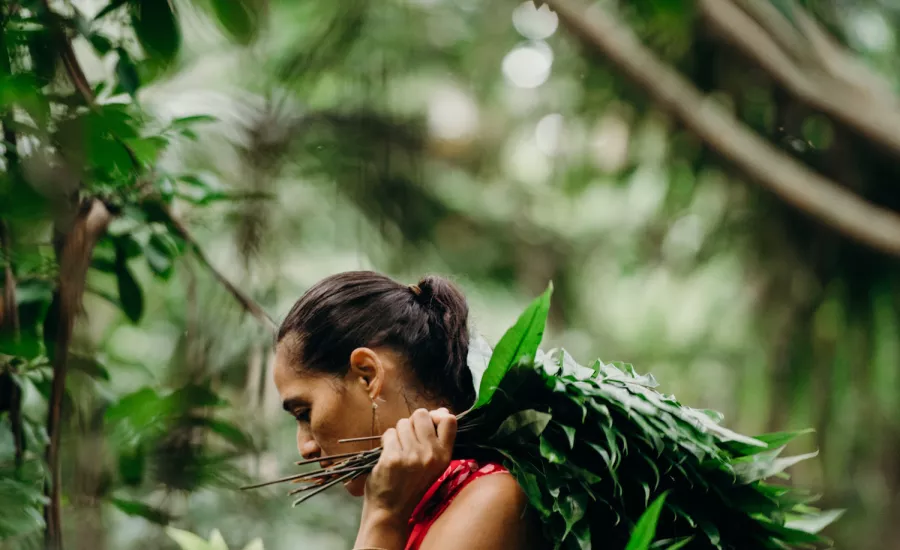Kau‘i Kanakaʻole
Waves crash against the distant black rocky cliff, salting the air. Kau‘i Kanakaʻole, the kumu hula (hula teacher) and her three students chant an oli, asking permission to enter the forest, and wait for a response. A breeze filters through the canopy, and the thick air parts, giving them their answer. They pick their way through the underbrush, beyond the grove of hala (pandanus) trees, to find the lauaʻe (monarch fern) leaves that generations of hula dancers have relied on to create their lei.
When they are worn during hula, the lei embrace the dancers with a touch of the forest. Their carefully gathered garb, the vibration of their voices, the rhythm of their instruments, the patterns of their movements and the story of their mele (song) all work together to replicate the environment. With their performance, they are literally connecting to Laka, the akua (deity) of hula and the physical, environmental process that keeps the forest alive. This is why every single part of the process—from gathering, to dancing, and returning to the ʻāina (land) once again—is filled with deep respect.


What is special about Hāna?
Hāna is pretty unique in that, historically, traditionally, it appears in many stories, many moʻolelo. Kauiki in particular is a hill that was referred to as a fortress because the ocean was the natural barrier on three sides, and only one side had to be fortified with warriors. And so, if the aliʻi were able to conquer Kauiki, they were able to conquer all of East Maui.
Who were the aliʻi?
Aliʻi for us is our chiefs of old and our aliʻi were direct links to the akua (deities). They were sacred because of their direct lineage to the akua.
So Kauiki became the seat of the aliʻi, and that's where they would hold their court and preside over East Maui. Many songs and hula were written and danced about this important stronghold.
And I think because of that history, because of the specialness of the place, which has to do with environmental resources of the area, the remoteness of the area, the energy has been kept intact. And the people and the families in the area are the same for many generations.
From a very young age, you know how to communicate with your environment through oli, through hula, through understanding the forest, and its importance to the ocean, and understanding all the different plants. And so it's important for a lot of people to return and make sure that our own kids have that same experience as we had, but also that we can keep that type of lifestyle intact.


"When you're going to a place that somebody is caring for, you walk a little lightly. You're a little bit more respectful. You're a little bit more mindful of your actions."
How can visitors help you keep that lifestyle intact?
They should understand that the people of this place have a very, very close relationship with the environment, and, you know, not just hula people. I just come from hula people. But, you know, there's fishing families, there's hunting families, there's families that farm taro, for generations, on the same land or at the same spot, down by the ocean.
And when you know, it's just like when you know when you're going to a place that somebody is caring for, you walk a little lightly. You're a little bit more respectful. You're a little bit more mindful of your actions. And I think if they knew that... I mean, if I knew that going into a place where I was gonna visit, I'd be super mindful of how I tread.

How do you share that with visitors?
At Ala Kukui we've been trying to instill that you cannot just come here and take. And when I say take, I don't mean take sand or take a rock. I mean, you can't just come here and breathe in this fresh air and experience this energy that we maintain - that we, as we live here, we have to maintain it. You have to give back in some way.
I tell people who come to Ala Kukui to do retreats, and a lot of them want to follow our protocol, but they don't know how to chant. And I say that, "You don't have to chant. That's the way we communicate with our environment. But if you're not from here, it's a simple ask: an introduction of who you are and an ask to enter into this space and what your intentions are for your time that you're here.”
And I think it's the reverberation of the voice that's important to come out in the environment, for that reciprocal relationship to start, even if it's just talk.
It all comes back to that reciprocal relationship that we have living here in this environment. We don't just take from it, you also give back. And there are so many ways to give back. As a visitor, it doesn't have to be monetary. It can be sweat. It can be just your words of mahalo, praise, acknowledging that relationship that the people maintain in whatever way you can.
了解夏威夷探险旅程
Please note: We apologize for any inconvenience, but our preferred business listings below are in English only.

